
| February 2002 | ||||||
| Sun | Mon | Tue | Wed | Thu | Fri | Sat |
| 1 | 2 | |||||
| 3 | 4 | 5 | 6 | 7 | 8 | 9 |
| 10 | 11 | 12 | 13 | 14 | 15 | 16 |
| 17 | 18 | 19 | 20 | 21 | 22 | 23 |
| 24 | 25 | 26 | 27 | 28 | ||
Wednesday 13 February 2002
At 1200, EST the Training Ship Empire State was located 23 nautical miles north of Moa, Cuba, at 21 degrees and 04 minutes North Latitude and 074 degrees 59 minutes West Longitude, steering course 280 degrees true at a speed of 10.7 knots/Rpm 48 turns. The weather was clear and excellent, winds from the east at 08 to 10 knots, air temperature was 82 degrees Fahrenheit, barometric pressure was 1020 millibars, seas were easterly at 5 to 6 feet, sea injection temperature was 78 degrees Fahrenheit. Depth of water beneath the keel was 2500 meters. ETA PORT EVERGLADES PILOT STATION, 0700 15 FEBRUARY 2002
CAPTAIN'S LOG
"I have an existential map; it has 'you are here' written all over it." - Steven Wright
Well, Mr. Wright is right. Every time I ask the cadet navigators where we are they point to the chart and reply, 'you are here'. At first, I thought to require a more quantative reply, that is, until I read Mr. Wright's quote and looked up the word existentialism. Existentialism is defined as a philosophy that emphasizes the uniqueness and isolation of the individual experience (ship) in a hostile or indifferent universe, (at sea) and stresses freedom of choice and responsibility for the consequences of one's acts... That sounds like Sea Term! So, the cadets are correctly reading existential charts of our hostile world. 'I am here'... I stand corrected.
'We are here' today, (north of Cuba) and moving smartly to the northwest. We passed Great Inagua Island to starboard, a few hours ago, and we will enter the Old Bahama Channel early this evening. Great Inagua is north but almost dead center between Cuba and Hispaniola, and the Island's southern shore defines the northern boundary of the Windward Passage. Given its' location, Inagua must have played an important part in the development of the West Indies. I am certain that early mariners would have concluded as we have; passage inside the Bahamas provides a much nicer, more predictable ride than sailing out and around. There is only one town and a lighthouse on Inagua; Matthew Town, at the southwest corner. Morton Salt operates a very large solar distillery there and from our vantage, that might give new meaning to the term, working in the salt mines. I wonder what people who live there do beside eat, sleep, and fish?
The water beneath us is deep and safe so the prudent mariner will have no problem navigating well clear of obstacles. However, shoals to the north bind the channel and the shallows at Lobos Cay funnels one into the mouth of the Old Bahama Channel. It is a narrow stretch of water between Cuba and the Great Bahama Bank. Passing through at night will be a spine tingling adventure for the deck watches and they will love it. I will update you on that experience if anything exciting happens.
Meanwhile, the "crunchies" are in their glory. Most of the surrounding waters are either designated marine sanctuaries, or highly patrolled and protected. Consequently, the cadets are having a field day observing sea life and conducting lab experiments.
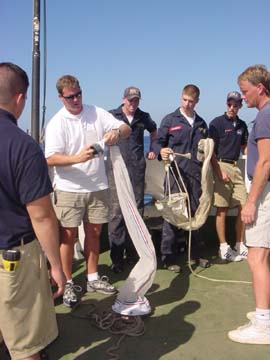
The stern is littered with scientific paraphernalia such as expendable bathythermographs, (XBT) and a plethora of more common items such as line, dragnets, shackles, and other things nautical. The Crunchies and Deckies actually work quite well together to make the collection contraptions operational. Occasionally, they are known to consult a sympathetic engineer as they put academic oceanography into real world practice.
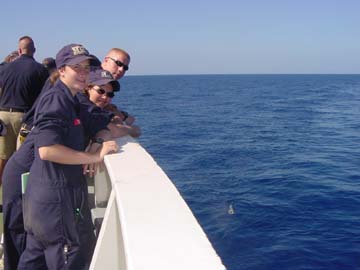
Our Learn - Do - Learn approach is clearly illustrated and amplified in the MSEP lab sessions. Unlike the training aids used in engineering and deck labs, much of the "equipment" in this course of study is rendered permanently inoperative when disassembly or it is microscopic in size. So, we are truly verifying in practice, that which we learn from texts and pictures.
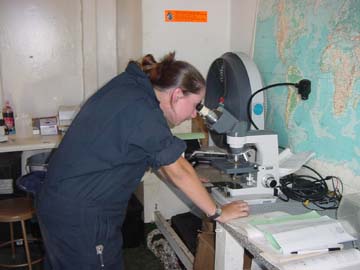
Other aspects of the MSEP curriculum, such as hazardous materials management, are in everyday use out here. All of the cadets are keenly aware of the dangers associated with mixing common cleaning products such as ammonia and chlorine and they have removed the most egregious from service. That is a relatively small problem to solve when one considers other personal safety requirements.
"Now, do not rotate, radiate, or transmit, from any mast or antenna, there are people working aloft." One is apt to hear those words when around large ships and they warn of particular hazards. However, nearly everyplace aboard is aloft and moving about on the exterior of a moving platform requires additional diligence. That training is part of Marine Safety too, and is required.
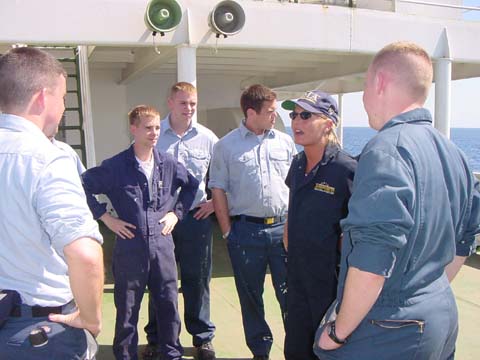
Most people will almost unconsciously climb a ladder to paint the house without a safety harness. But if a fall occurs the house will not steam away while one regains his bearings. Freedom of choice and responsibility for the consequences of one's acts are fine on paper and they were covered in the 'Learn' phase. The 'Do' segment teaches everyone to protect themselves from real world hazards that exist in the hostile, indifferent universe at sea. The pictures illustrate one segment of the mandatory safety training that is a part of the MSEP course of study.
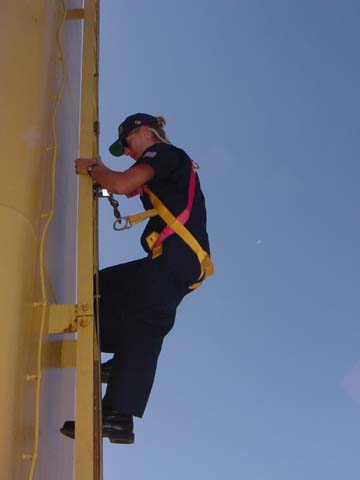
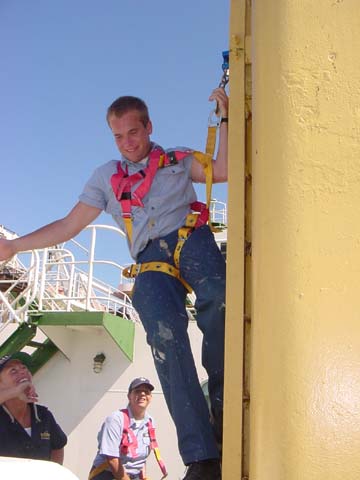
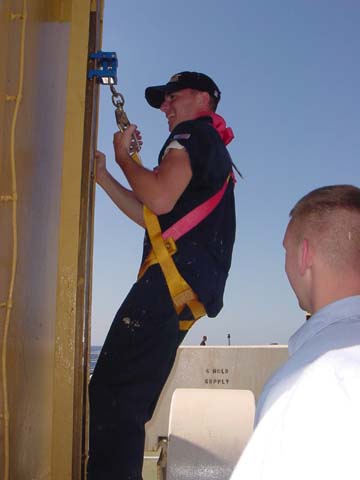
Well folks, I don't want to leave you hanging...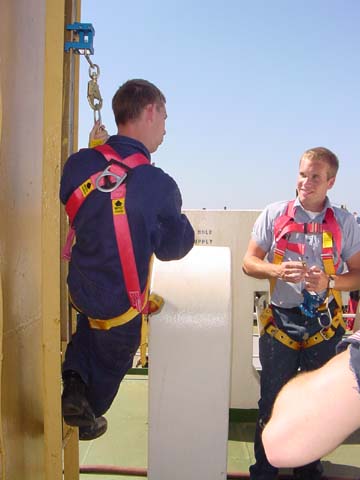 ...
...
but that's a wrap for today. Just remember... 'you are here'... with me, and tomorrow we will be there, just northwest of the Old Bahama Channel.
See You then.
CADET'S COMMENT
Marine Safety and Environmental Protection By Cadet 1/C Mike Simonelli Cruise Environmental Operations Officer (Head "Crunchie")
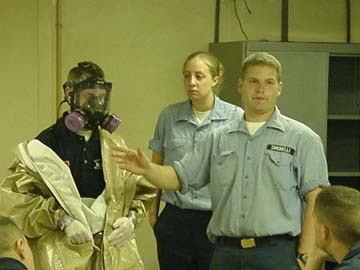
During the course of the 2002 Sea Term, all freshmen will complete one week of environmental protection and marine safety classes. Their daily schedules include three hours of lectures and three hours of labs. If they have lectures in the morning, then they will participate in labs in the afternoon and vice versa. Because we only have one week to expose the freshmen to the major, we try to be as diverse as possible when choosing the sea term classes. Consequently, they get a feel for all aspects of the major. In addition, while everything covered in the labs is studied in more depth later on, keep in mind that what we teach on sea term lends itself to the shipboard environment.
The Marine Safety and Environmental Protection degree consists of a variety of courses and topics. The classes range from biological, ecological sciences, and management, to OSHA regulations, safety protocols, and coastal structural engineering. Fourth-class cadets (Freshmen) participate in Physical Oceanography, Chemical Oceanography, Biological Oceanography, Marine Pollution, and Personal Protection. Matching labs are taught in order to present the practical purposes of classroom education.
Upon completion of the classes and labs, cadets hand in their lab manuals and take an exam. Let me dispel the notion that all the MSEP major consists of is tree hugging and playing with phytoplankton. Many students have not touched phytoplankton since freshmen Sea Term. Some immerse themselves in these topics but I found myself more involved in hazardous materials, oil spill response, and health and risk assessments. The main advantage of MSEP is the ability to tailor the education to a desired goal. While the major does not lead to Coast Guard licenses, it provides opportunities to obtain outstanding certifications and qualifications that are highly sought by industry.
Environmental issues are worldwide concerns and good jobs are created everyday to accommodate these needs. We are in increasingly demand. So the next time someone asks that age-old question, "Deck, or Engine", respond with, "I don't know, isn't there something to that MSEP major?"
QUESTIONS FOR THURSDAY 14 FEBRUARY 2002
MATH: The cadet window solution contains 4 percent ammonia by volume. How many ounces of ammonia are contained in one quart of window solution? (Hint: 1 quart = 32 ounces.)
SCIENCE: The process by which moving wire through a magnetic field produces current is called___________.
GEOGRAPHY: The part of our trip to the West Indies and Caribbean is over. What sweet memories we have! Speaking of sweet memories, and Valentine's Day, what product did the Aztecs harvest that is used as a symbol of affection at Valentine's Day? Columbus brought some of this back to Spain on his fourth voyage.
HISTORY: Happy Valentines Day! Here are a few questions about this special day:
1. Why is the heart used on valentines? 2. Why is an "X" used for a kiss? 3. Why do some cards have lace on them?
ANSWERS FOR WEDNESDAY 13 FEBRUARY 2002
MATH: 20 percent (1/5) of 10 ounces is 2 ounces. The new solution contains 10 ounces + 40 ounces = 50 ounces So, 2/50 = 4/100 or 4 percent
SCIENCE: Generator
GEOGRAPHY: Almost daily, the ship has reported winds from the northeast. These winds are called trade winds. They are very dependable and were important when sailing ships carried cargoes around the globe. The trades blow from high pressure at around 30 degrees latitude to low pressure near the Equator. Both the Northern and Southern Hemispheres have trade winds, but the southern trade winds blow from the southeast
HISTORY: This man called himself "Blackbeard".